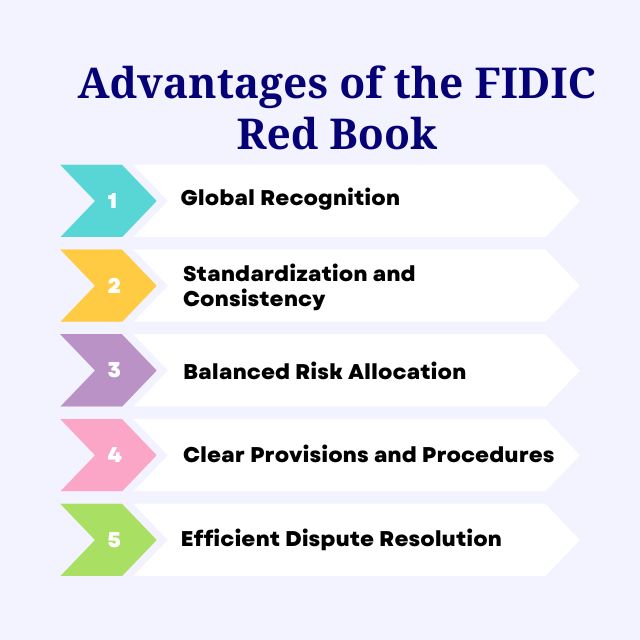The FIDIC Red Book, officially titled “Conditions of Contract for Construction for Building and Engineering Works Designed by the Employer,” is one of the most commonly used standard contracts within the FIDIC suite. Developed by the International Federation of Consulting Engineers (FIDIC), the Red Book provides a robust framework for governing construction projects where the contractor is responsible for executing the works based on the employer’s design. This article will explore the key features, advantages, and significance of the FIDIC Red Book in the construction industry.
What is Red Book in FIDIC?
The FIDIC Red Book was first published in 1957 and has since undergone several revisions to reflect the evolving construction industry practices and address the specific needs of various projects. Its primary purpose is to establish a fair and balanced contractual relationship between the employer and the contractor, providing a clear understanding of their respective obligations, responsibilities, and risks.
Related Post: Contract redlining
Key Features of the FIDIC Red Book
- Roles and Responsibilities: The Red Book outlines the roles and responsibilities of the employer, contractor, and engineer. It defines their duties during the various stages of the project, from design and procurement to construction and completion.
- Design and Execution: In Red Book contracts, the employer is responsible for providing the design, and the contractor is responsible for executing the works accordingly. The contractor must adhere to the employer’s design and specifications while ensuring contract compliance with local regulations.
- Time for Completion: The contract stipulates a clear timeframe for project completion. The contractor is obliged to complete the works within the specified duration, failing which the employer may claim liquidated damages as compensation for the delay.
- Payment Terms: The Red Book includes provisions for payment, typically based on milestones or completed works. The engineer, acting as an impartial professional, certifies payments to ensure fairness and transparency.
- Variations and Change Management: Construction projects often encounter changes due to unforeseen circumstances or design modifications. The Red Book provides a clear procedure for contract management variations, ensuring that any changes to the scope of works are documented, evaluated, and compensated fairly.
- Testing and Defects Liability Period: The Red Book includes provisions for testing and commissioning to verify that the completed works meet the specified requirements. Additionally, it establishes a defects liability period during which the contractor is responsible for rectifying any defects that arise.
- Risk Allocation: Different FIDIC contract types, including the Red Book, strive to allocate risks fairly among the parties involved. The contract delineates the risks that each party must bear, promoting a cooperative environment and preventing an unreasonable burden on any party.
Also Read: Can you notarize for family in NY
Advantages of the FIDIC Red Book

- Global Recognition: The FIDIC Red Book is widely recognized and accepted internationally. Its use facilitates negotiations and ensures consistency in construction project governance across different legal systems and countries.
- Standardization and Consistency: The Red Book’s standardized format and structure help ensure that all parties understand their rights, obligations, and responsibilities under the contract, reducing ambiguity and potential disputes.
- Balanced Risk Allocation: By allocating risks fairly, the Red Book promotes a cooperative environment where each party can focus on their core tasks, enhancing project efficiency and reducing the likelihood of disputes.
- Clear Provisions and Procedures: The Red Book incorporates clear and detailed provisions covering essential aspects of the construction project, including design, payment, variations, and dispute resolution. This clarity fosters transparency and legal certainty.
- Efficient Dispute Resolution: In the event of disputes, the Red Book offers multiple avenues for resolution, such as negotiation, adjudication, and dispute boards. These mechanisms aim to resolve conflicts quickly and amicably, avoiding costly and time-consuming legal battles.
The FIDIC Red Book is an essential and widely used standard contract in the global construction industry. Its well-defined structure, balanced risk allocation, and clear provisions make it a valuable tool for governing construction projects where the contractor executes the works based on the employer’s design. By fostering fairness, transparency, and efficient project execution, the Red Book continues to play a significant role in the successful delivery of construction projects worldwide.
Did you find this Legitt article worthwhile? More engaging blogs about smart contracts on the blockchain, contract management software and electronic signatures can be found in the Legitt Blogs section. You may also contact Legitt to hire the best contract lifecycle management services and solutions along with free contract templates.
Frequently Asked Questions About FIDIC Red Book
What is the FIDIC Red Book?
The FIDIC Red Book is a standard contract used for construction projects where the contractor executes works based on the employer's design, providing a robust framework for contractual relationships.
What are the key features of the Red Book?
Key features include roles and responsibilities definition, employer-provided design, time for completion, payment terms, variations management, testing, and defect liability provisions, and balanced risk allocation.
How is risk allocated in the Red Book?
The Red Book aims for balanced risk allocation among parties based on their roles and responsibilities, promoting fairness and avoiding an unreasonable burden on any party.
What are the advantages of using the Red Book?
Advantages include global recognition, standardization, balanced risk allocation, clear provisions, and efficient dispute resolution, fostering transparency and successful project execution.
Who is responsible for providing the design in the Red Book?
In the Red Book, the employer is responsible for providing the design, and the contractor is responsible for executing the works accordingly.
Can the employer claim damages for delays in project completion?
Yes, the employer may claim liquidated damages for delays in project completion by the contractor, as specified in the contract.
What does the defects liability period entail?
The defects liability period in the Red Book requires the contractor to rectify any defects that arise in the completed works during a specified period after project completion.
Is the Red Book suitable for international construction projects?
Yes, the FIDIC Red Book is suitable for international construction projects due to its global recognition and standardization, ensuring consistent governance across different legal systems.
